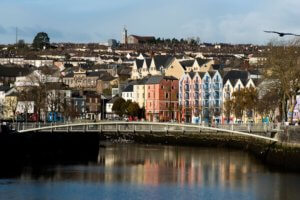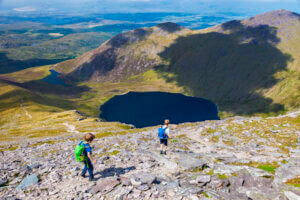Given the Emerald Isle’s long history of conflict, it should be no surprise to anyone that several castles, jails, and cemeteries would be haunted. To whet your appetite for the paranormal, here’s the lowdown on 9 of the most haunted places in Ireland.
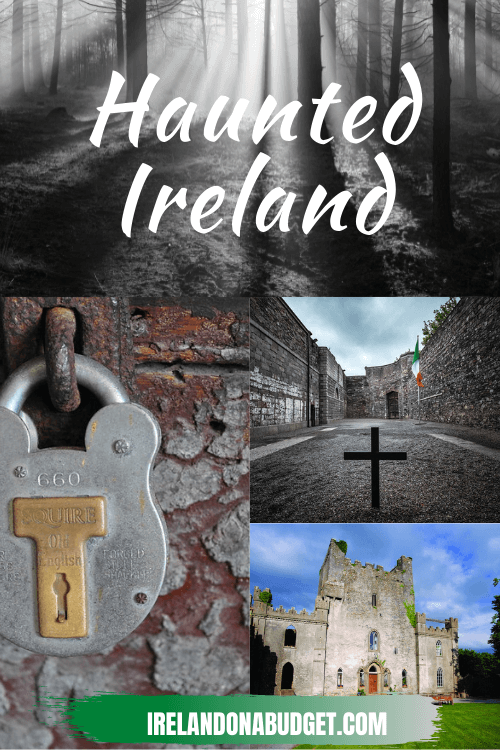 This post and page contain affiliate links and I may earn compensation when you click on the links at no additional cost to you.
This post and page contain affiliate links and I may earn compensation when you click on the links at no additional cost to you.
Athcarne Castle, Co. Meath
While the castle you see today was built in the 16th century, its original tower house was constructed in the 12th century by Hugo De Bathe, an Anglo-Norman knight from Bath, England, who came to Ireland when the first Normans invaded, most likely with Strongbow (the Earl of Pembroke).
Historians believe that the first structure was actually built on a cairn (constructed thousands of years before by the Ancient Celts for burial purposes).
The Anglo-Normans commonly built on such places as they were located on hills.
This one was close to the river and in general, was considered a good defensive site.
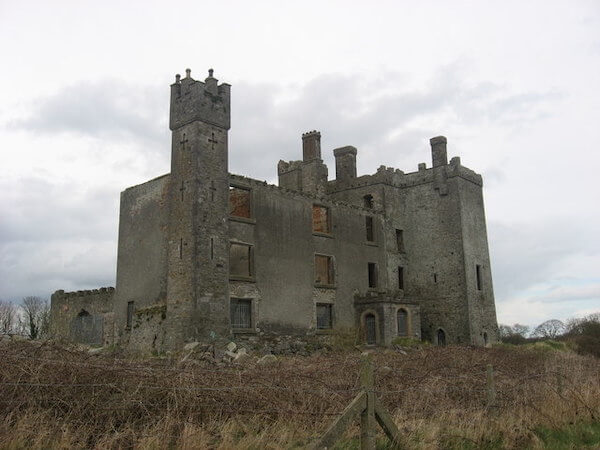
Athcarne Castle was significantly extended in 1590 by Sir William Bathe.
One hundred years later, King James II slept in the castle on his way to the Battle of the Boyne, which took place about six miles away.
It is where the king and 1,500 men lost their lives in a bloody sectarian conflict that shaped the history of Ireland forever.
Stories of people hearing the cries of dying soldiers and the vision of someone hanging from a nearby oak tree are just some of the spooky tales associated with this now derelict structure in the care of the Irish State.
The ghost of King James is also believed to haunt this eerie place.
Get Wifi Across Ireland with Wifi Candy (use code irelandonabudget for 10% off your order)
Charleville Castle, Co. Offaly
Believed to be the most haunted building and grounds in Europe, Charleville Castle is among 8 of the most haunted places in Ireland and also one of Ireland's finest examples of Gothic architecture.
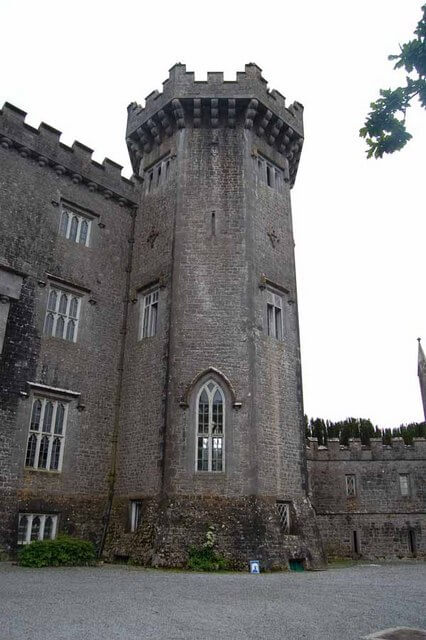
The castle’s haunted reputation comes from the tale of an 8-year-old girl named Harriet who died in the house in April 1961 after a fall from the staircase.
Her ghost is believed to wander its halls, with visitors hearing her laugh, sing and scream in the middle of the night.
The castle, located close to the town of Tullamore, has been featured on Living TV’s “Most Haunted” and Fox Network’s “Scariest Places on Earth.”
Numerous paranormal investigators and psychics have also visited the castle, which was built by the Earl of Charleville.
It was also one of the locations for the popular movie “Becoming Jane” starring Anne Hathaway.
The castle was built in 1798 for the Earl of Charleville, Charles William Bury.
Taking 14 years to complete, this grand building includes two grand staircases, ornate plaster ceilings throughout, including a William Morris stenciled ceiling in the dining room.
The castle is open to visitors but only if you contact the owners by email or phone. Contact details can be found here.
Duckett’s Grove, Co. Carlow
A Gothic Revival-style house that has dominated the County Carlow landscape for over 300 years and known as Duckett’s Grove is another one of the most haunted places in Ireland.
Legend has it that a curse, or as they say in Ireland, a “piseog” (pronounced pishoag) was put on the family that would bring about death, despair, and financial ruin.
The curse was cast by the angry grieving mother of a young girl, the lover of William Duckett, the owner of the estate.
The young lady had fallen from a horse on the estate some weeks earlier.
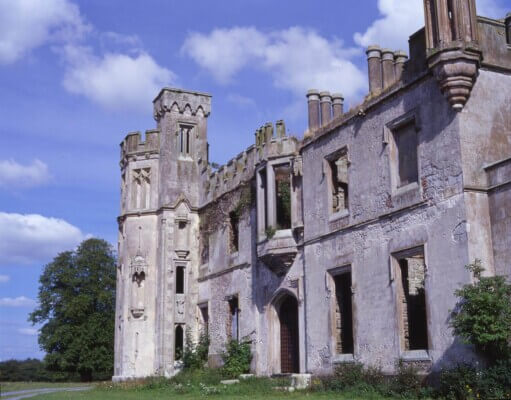
Some of the spooky events at the property include the voices of servants who would have worked in the castle’s kitchen and pantry, sightings of a phantom horse and carriage rolling up to the former entrance, as well as bangs, floating balls of light, spectral shadows, and apparitions of various figures.
The derelict house, complete with towers and turrets, has attracted paranormal seekers for years.
In 2011, it was featured on Syfy’s “Destination Truth,” a weekly paranormal reality TV series.
The house was built for the Ducketts between 1815 and 1850.
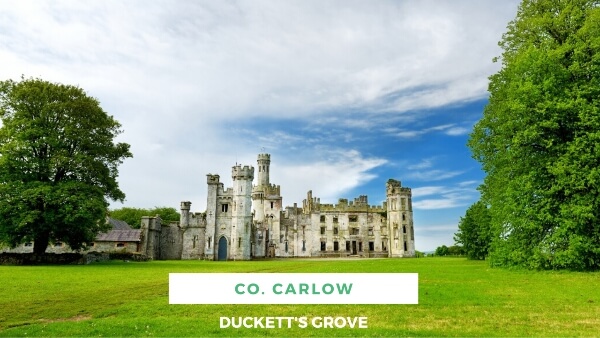
They were the largest landowners in all of Carlow, owning approximately 12,000 acres.
The house was destroyed by fire in 1933.
In 2005, Carlow County Council took it over and began to renovate the grounds, including two beautiful Georgian walled gardens.
The estate, which is free to explore, is open year-round. There are tea rooms on the property open Saturday through Tuesday from 12 to 5 p.m.
Read More: County Carlow: The Celtic Center of Ireland
The Battle of Aughrim Battlefield Site, Co. Galway
If the Battle of Culloden of 1746 was the bloodiest fought on Scottish soil, the Battle of Aughrim in Ireland in 1691 is similar because of the enormous death toll that resulted on the fields of this rural part of Co. Galway.
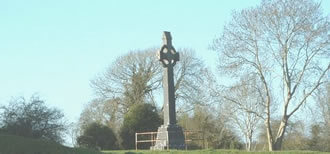
This singular event was the decisive battle in the Williamite War in Ireland.
The conflict occurred between those who supported James II, the last Catholic monarch of England and the Protestant William III who succeeded him.
Up to 40,000 men took part in the ferocious battle.
Between 5,000 and 7,000 people were killed, their corpses left on the battlefield for up to a year or more and their rotted bodies eaten by wild animals.
While the battle was initially going the way of the Jacobites, their fortunes reversed when General St. Ruth, a French commander who was sent to Ireland by King Louis XIV to help the Irish cause, was decapitated by a cannonball and as a result, the Jacobites were forced to retreat.

The Williamiates pounced on the fleeing soldiers, slaughtering them as they tried to run away.
One area of the battlefield, known as the Bloody Hollow, is where apparitions of Jacobite soldiers have apparently been seen, along with a ghost dog who was with his master when he was savagely killed.
A Celtic cross marks the site where St. Ruth was killed.
A nearby interpretive center tells the story of this horrific battle in more detail, with displays of the battlefield and more.
See Dublin's Many Attractions with the Go City Dublin Pass
Kilmainham Gaol, Dublin
It’s not surprising that this Victorian prison, where 14 leaders from the Easter Uprising of 1916 were executed, is known also for its haunted activity and is among 8 of the most haunted places in Ireland.
Phantom footsteps, haunting voices, and flickering lights are just some of the things that make it another one of the most haunted places in Ireland.
The strange events were not noticed until the building had long ceased to be a prison and in 1960, the Kilmainham Gaol Restoration Committee was in the process of renovating it.
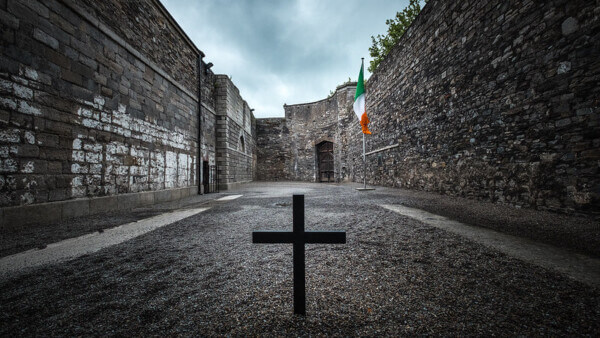
One of the most notable occurrences was when a volunteer while painting an area of the prison’s dungeon, was pinned up against the wall with an unseen force. The man had to fight his way out of the dungeon and never returned.
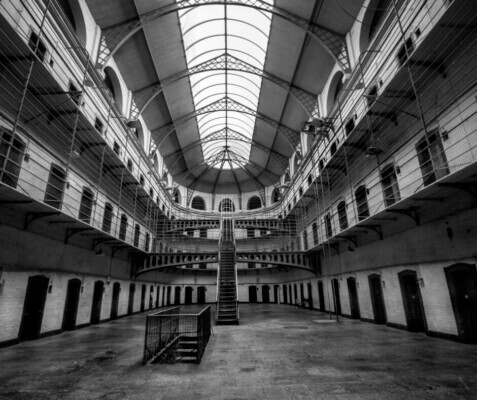
Other paranormal happenings include cell doors banging shut and footsteps climbing the stone stairs as well as the corridors, with the sounds of a soldier’s brigade in the background.
A tour of the museum covers some of the most tragic events in Ireland’s struggle to break away from British rule, from the 1780s right up to the 1920s.
Admission for adults is €8; for seniors (60+) and students, €6; for children (12-17), €4; and for a family of 4 or 5, with children under the age of 18, €20.
Leamaneh Castle, Co. Clare
Have you heard of Red Mary?
Known for her flaming locks and fiery temper, Mary MacMahon lived in Leamaneh Castle with her husband, Conor O’Brien.
Mary ruled the castle with an iron fist, often hanging servant girls from the windows by their hair until they died, as well as kicking one of her husbands to death.
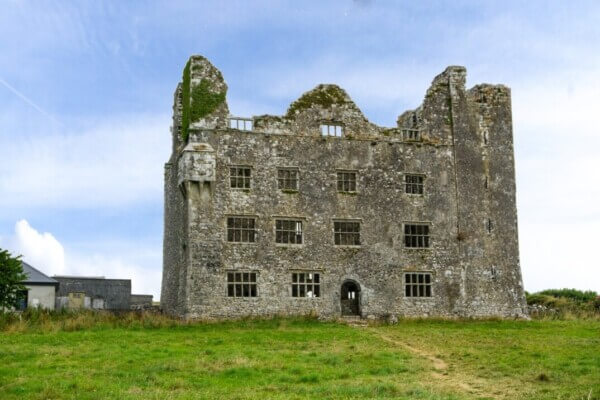
She also encouraged visitors to ride her wild stallion that would send them to their deaths over the nearby Cliffs of Moher.
As shrewd as she was fiery, Mary was wise enough after her husband’s death to marry a Cromwellian soldier in order to hold on to her land.
And after his death, legend has it that she married 25 or so other men!
It’s not surprising that Mary made enemies throughout her lifetime. Legend has it that she was eventually captured, encased in a hollowed-out tree, and starved to death.
The abandoned castle is said to be haunted by Mary’s screams.
Because the castle is privately owned, visitors are not allowed to get close to it.
Leap Castle, Co. Offaly
Leap Castle was built in the early 1500s by the O’Carroll clan. It is also one of the most haunted places in Ireland.
The O’Carrolls were a terrifying lot, to say the least! They often used the castle grounds to stage the massacres of rivals and also to kill each other. Their dinner guests were not safe, either. And neither were the soldiers who reported to them.
The castle is currently owned by Sean and Anne Ryan, who are happy to give self-guided tours of the upper floors of the castle.
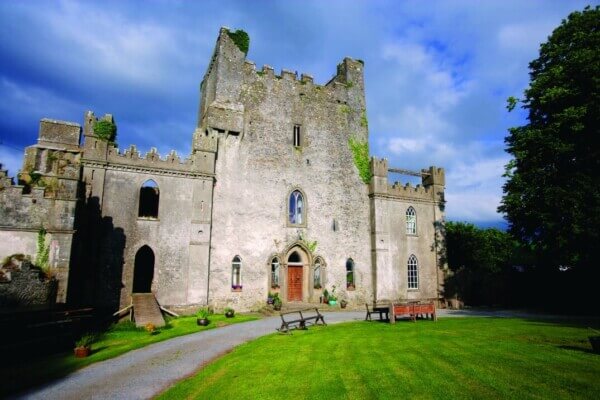
The couple claims that ghosts actually exist and that they have seen them, making this among 9 of the most haunted places in Ireland.
One of the most interesting parts of the castle is “The Bloody Chapel,” where the one-eyed Teigue O’Carroll murdered his brother while he was saying mass.
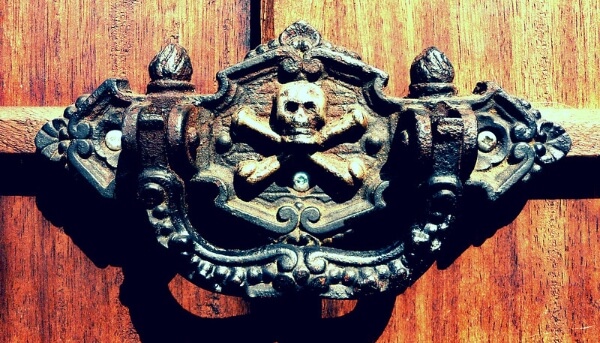
After the castle was destroyed in 1922 during the Irish Civil War, repair work uncovered a secret dungeon filled with corpses that were thought to have been the victims of the ghastly murders.
To visit Leap Castle, contact the owners directly at the website listed above.
Montpelier Hill, Co, Dublin
Be sure to bring someone with you before you trek up this hill at night.
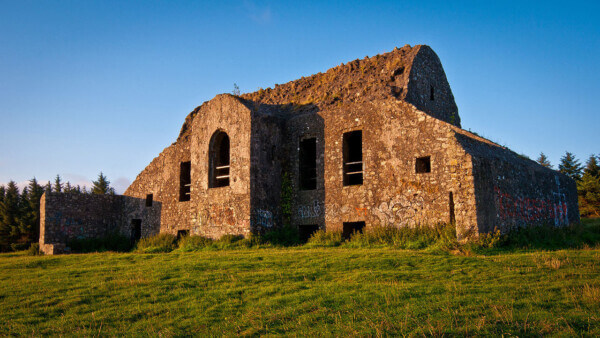
The building on Montpelier Hill, commonly referred to as the “Hell Fire Club,” has been the location for numerous supernatural sightings.
The hunting lodge was originally built by William Conolly, the speaker of the Irish House of Commons, in 1725.
Connolly was also the owner of Castletown House, a popular tourist attraction in Co. Meath.
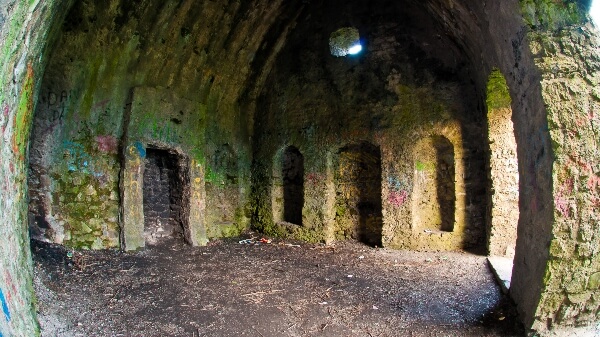
During the construction of the lodge, workers took stones from an ancient passage grave and cairn, which some say brought bad luck to the building.
Shortly after it was finished, the slate roof was blown off the building.
Conolly had the roof repaired and again asked workers to take stones from the cairn.
Rumors were rife that all sorts of immoral happenings took place within the walls of the lodge, including drunkenness, orgies, devil workshop, sacrifices, even murder.
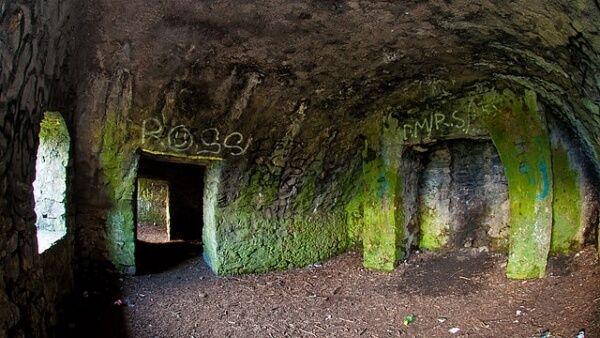
During a game of cards one night, a guest arrived with cloven hooves. Another time, the lodge caught fire during the sacrifice of a dwarf, and several members were killed.
There’s no knowing for sure if any of this happened, but several paranormal sightings have taken place at the old hunting lodge.
Read More: 5 of the Best Day Trips from Dublin
Wicklow Gaol, Co. Wicklow
A few years ago, Wicklow Gaol was listed as one of the most haunted places in the world, which puts it up beside other famous jails like Alcatraz off the coast of California.
The jail, which opened in 1702, was known for its brutality and corruption.
Most of its prisoners had been captured for their participation in various rebellions against British rule.
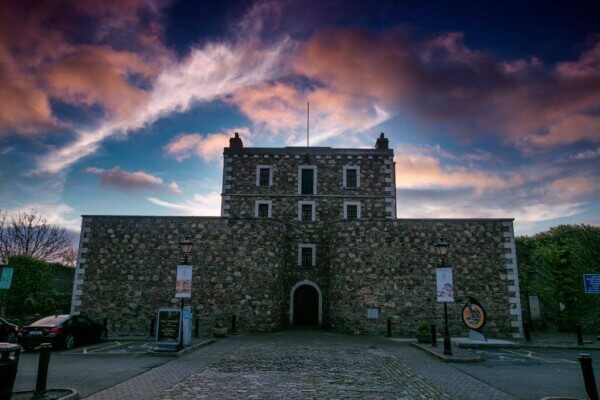
There are several tours available at the jail.
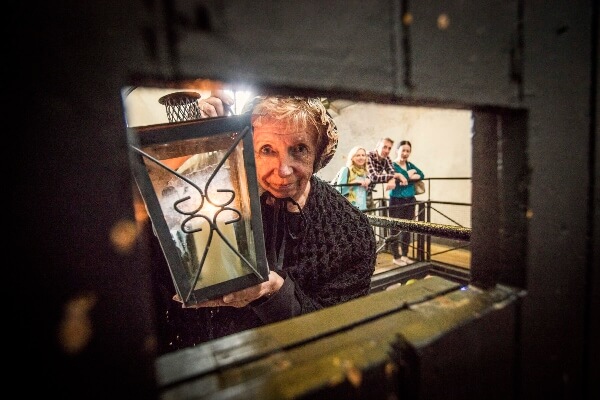
They include the Virtual Reality tour, a fully immersive experience that transports visitors back in time; a series of day tours, where you’ll meet Mary Morris, the matron of the Victorian prison; a night tour led by professional actors in period costume; and a paranormal tour.
Are there other haunted places in Ireland you’ve visited that are not listed here? If so, let me know in the comments below.
And as always, feel free to sign up for my regular e-newsletter for more tips and information on getting to Ireland on a budget.


